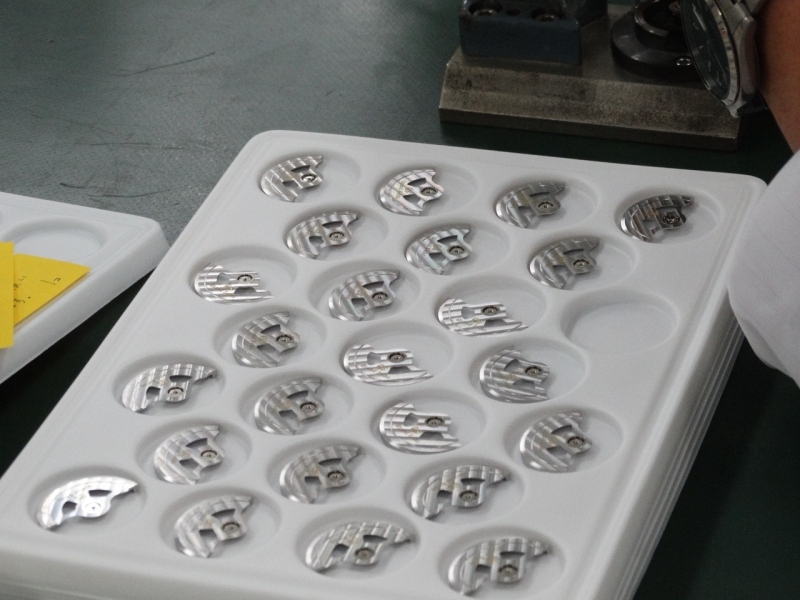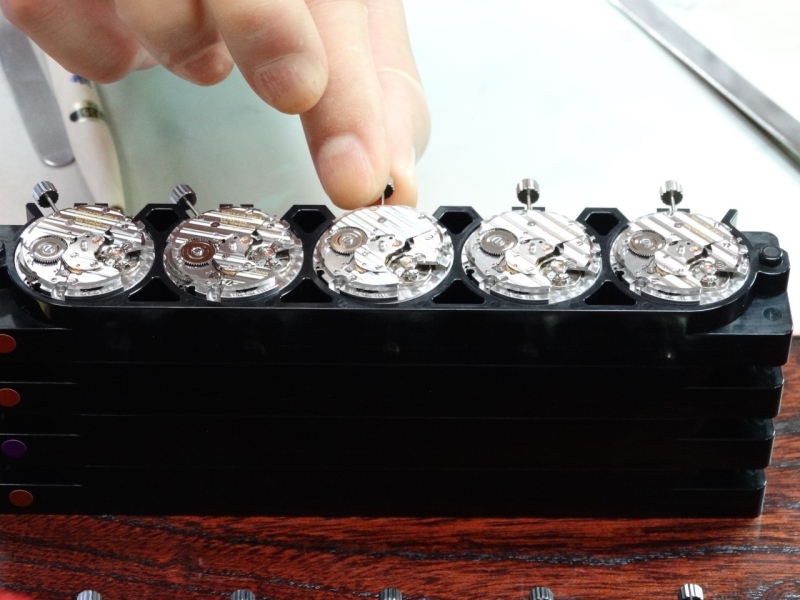
cazalea
[Seiko Moderator]
17049

VISIT TO SEIKO PART 3: Mechanical Watch Movements
Mechanical movements are assembled in the Shizukuishi Watch Studio at Morioka Seiko Instruments, Inc.
As you may recall if you've read previous reports, this studio is located hundreds of miles north of Tokyo in a quiet alpine area. We took the bullet train (more on that later).

Quiet forests surround the facility that was built in 2004.

A wooden clock in the lobby testifies to the forests outside. The leaves are just changing, so if you like that autumnal effect, SEIKO says this is a GRAND time to visit the area.

Notice the fabulous wooden watchmaker's benches! These are made to order and reflect the prestige given to this group of crafts persons. A couple dozen out of the 600 or so that work here.
What do the rest of the people do? Well, they create about 8 million movements a month for Seiko's main line of watches. All that in a room 50m x 70m, with production lines running 24 hours a day.
The craft studio has doubled their production of Grand Seiko, Credor, Galante and Ananta watches in the past couple of years, and look to doubling it again soon. Although I would guess that's about 10 minutes of the quartz production ....


This lady is locking (welding?) the rotor bearing into the rotor.




Meanwhile the rest of the movement is being assembled in the same room.

A few finishing touches and the watch comes to life before our eyes.


If you are not so much into trees but like round shiny things better, you have come to the right place. Shizukuishi is full of beautiful round objects. Here are some base plates being prepared.

This lady is locking (welding?) the rotor bearing into the rotor.

And here some finished Grand Seiko winding rotors, complete with bearings and fully decorated with lettering, gold paint and stripes.

Extra decoration or engraving is available too, on Credor models. This is too flashy for the Grand Seiko customer.

Extra decoration or engraving is available too, on Credor models. This is too flashy for the Grand Seiko customer.

In case I forget to mention it elsewhere, this workshop produces all the cutting tools used here - from CNC cutters to special engravers formed to the palm of the artisan who wields it!

This master tweaks the hairspring by hand. He can do many a day - it only takes him a few minutes per watch. Most people could never do this.

Meanwhile the rest of the movement is being assembled in the same room.

A few finishing touches and the watch comes to life before our eyes.

Finished movements (minus the winding rotors).

Raw movements are fitted with test dials and run for a week or two. This is observed by cameras to detect any issues.

Assuming everything goes as planned, then dials and hands are installed on the movements. (Those are made by Seiko; see Part 2 of my report)

This facility also produces some gold Grand Seiko watches.

Raw movements are fitted with test dials and run for a week or two. This is observed by cameras to detect any issues.

Assuming everything goes as planned, then dials and hands are installed on the movements. (Those are made by Seiko; see Part 2 of my report)

This facility also produces some gold Grand Seiko watches.

Here is the dial setting person, hard at work.

Now that I know how much trouble it is to produce a flawless dial, I think I'd pass on working at the dial setting station.

I'm not sure the tweezers are gold, but they sure are pretty. And part of the job is the bend or curve the hands to match the domed dials. Sheesh! No pressure here, eh?

I was tempted to ask "Witschi Doing?" but couldn't think how that pun would play in Japanese, so I skipped it. These are Swiss timing machines.

She's doing another preliminary test before the watches get cased and tested.

She's doing another preliminary test before the watches get cased and tested.
This looks great in person. I hope the photo does it justice.


Finished and cased watches are pressure tested, then water tested in a big tank, then placed on a drying towel over a heated plate.

Everyone likes to see their name in lights, but the real stars today are the folks building Grand Seiko and Credor and Galante movements up in Morioka.


I hope this series is entertaining and enlightening. Please continue to read as we go to Part 4.
Cazalea
This message has been edited by cazalea on 2014-10-19 20:23:36
This message has been edited by cazalea on 2014-10-21 05:47:25
More posts:

VISIT TO SEIKO PART 3: Mechanical Watch Movements
Thanks for reading Part 2 of this report. I suppose it is time to get to the heart of things for most PuristS (please don't give up here though). Mechanical movements are assembled in the Shizukuishi Watch Studio at Morioka Seiko Instruments, Inc. As you ...

Love to see Shizukuishi factory any time...
... think they are all "machine"? No! They are all for precision and they do adjust, assembling, and finishing everything by hand. That is "craftsmanship" Japanese way! Thanks, Mike! Ken

Not so sure that they do
Seiko Epson does make some industrial robots that they pointed out to me, but I also saw some from Fanuc Robotic. I'm not conversant with the manufacturers of CNC but I'm sure some of the larger machines were the same ones my friend operates here in SoCal...

Being the curious sort, I . . .
. . . 'blew up' this photo . . . . . . to see the timing results. If I ever get another new GS, I hope it has the movement connected to the timing machine on the right. :-) ...

Did you see the note pad in front of her?
Fear not - you wouldn't expect them to track the timing results with pencil on a pad would you? This is the first preliminary test, when the watches first come to life. If I remember correctly, they run for a week or 10 days, then go to be adjusted and fo...

craftsmanship at the Shizukuishi studio
Nic pics cazalea. Great to see the fine craftsmanship at the Seiko Shizukuishi studio. Regards, ED-209

Am I correct, is this only place they make their high end watches
And how many do just a dozen or so of those people turn out each year? Cheers Steve

no, they make them in several places
Grand Seiko and Credor mechanical movement watches are made in Shizukuishi. The very high end Credor watches (minute repeater, sonnerie, Eichi, etc) plus Grand Seiko Spring Drive and Quartz models are made in the Seiko Epson studio in Shiojiri. I am guess...

This has been my favorite part so far...
There's a precision here that's different than the Swiss precision and yet it rivals that Swiss precision. There's also something even more scientific feeling about this factory than the ones that I've seen in CHF. For one thing, the equipment here is new...

Hi Patrick, you are right
I've been to 10-12 other watch companies and these studios seemed more precise, cleaner, more clinical. They are large compared to many Swiss facilities, excepting JLC, I suppose. Thanks for reading. Mike
